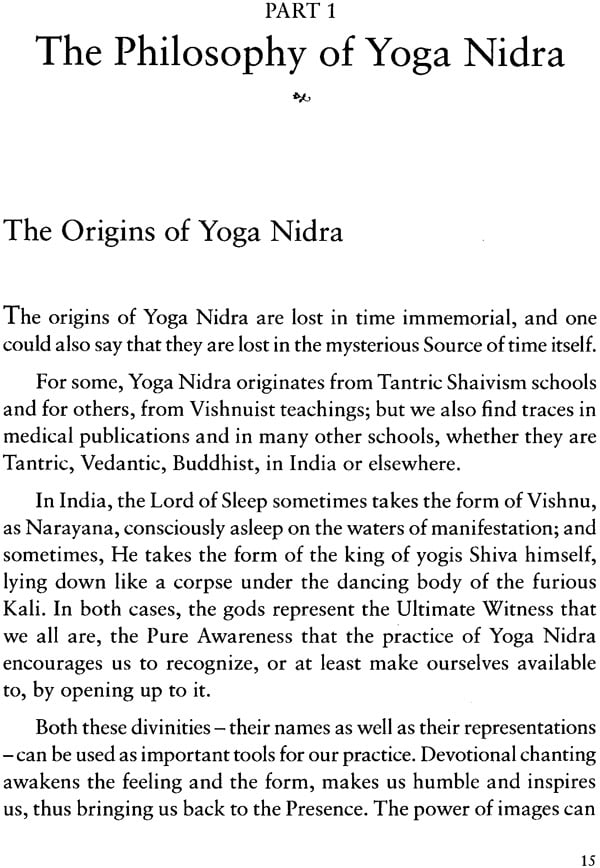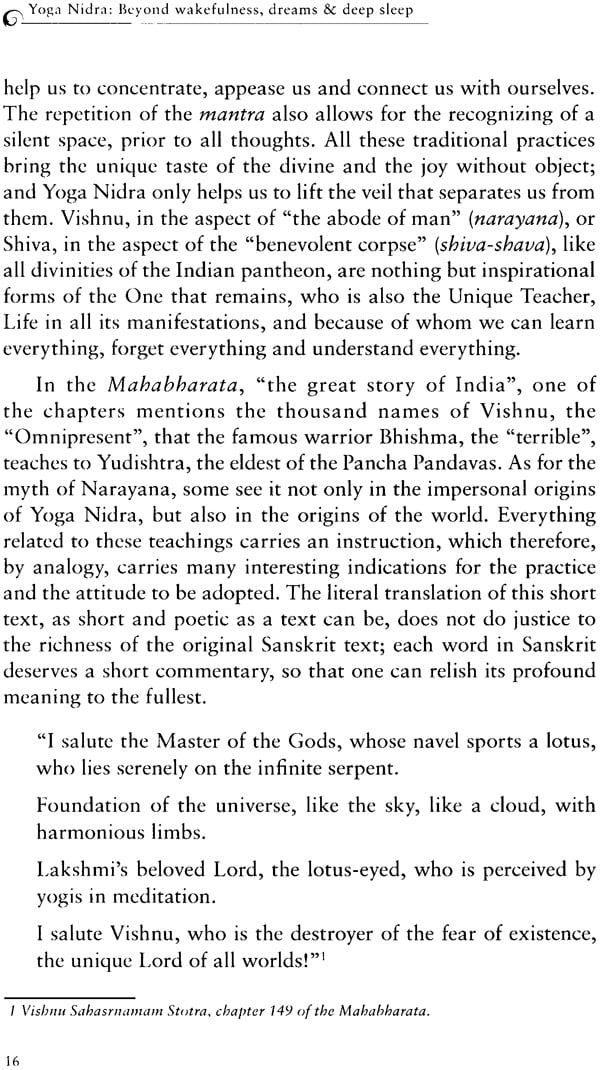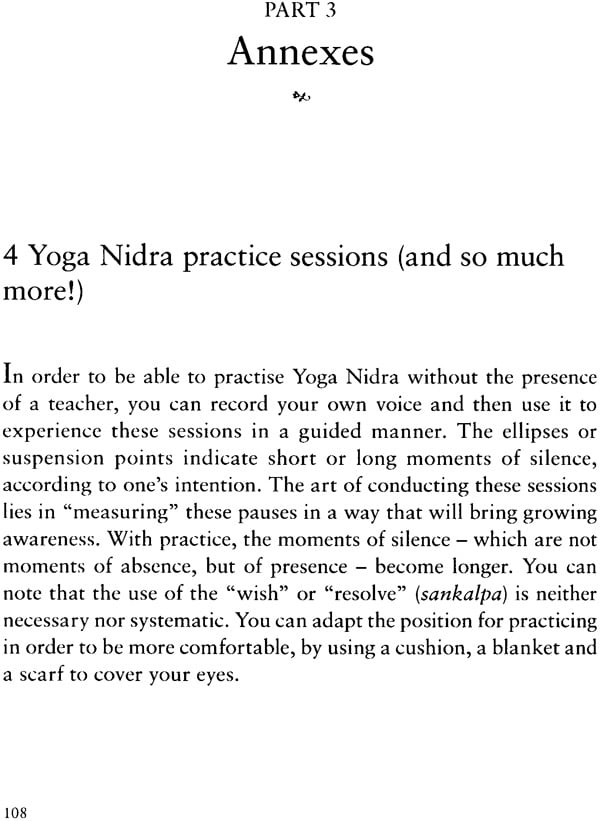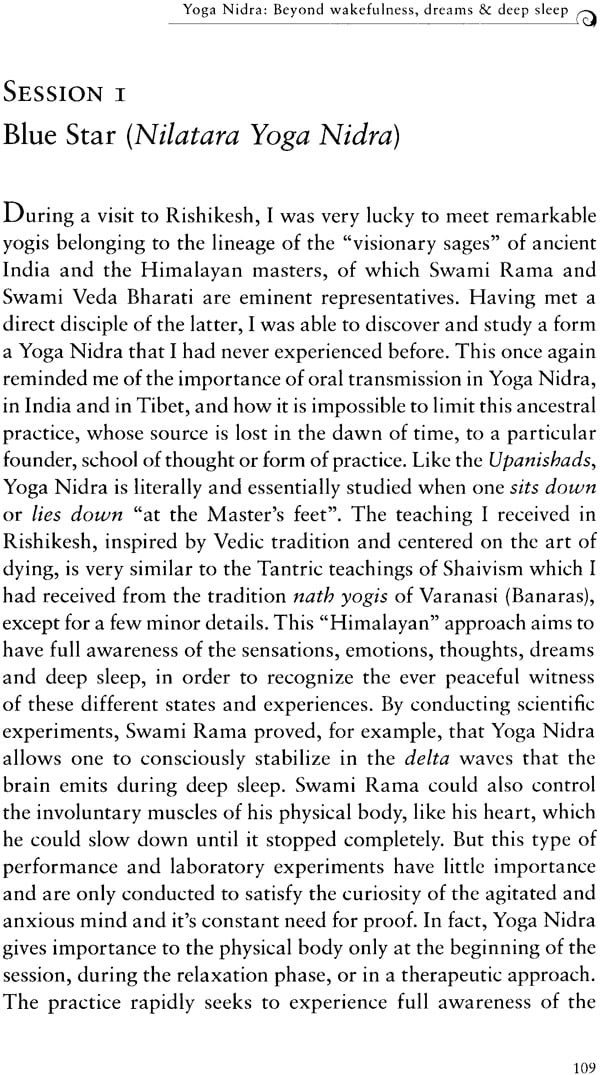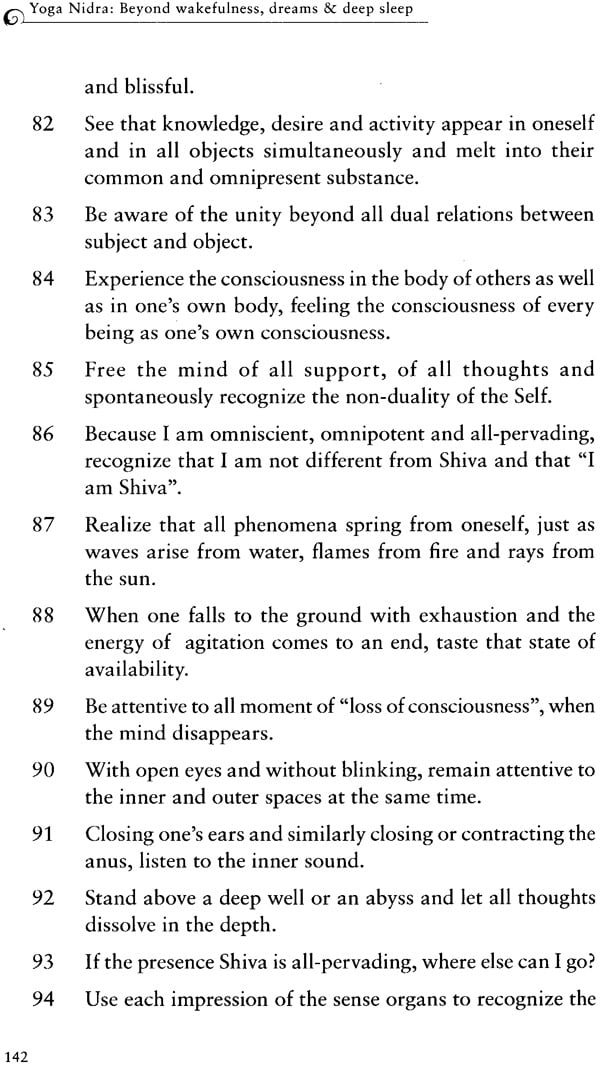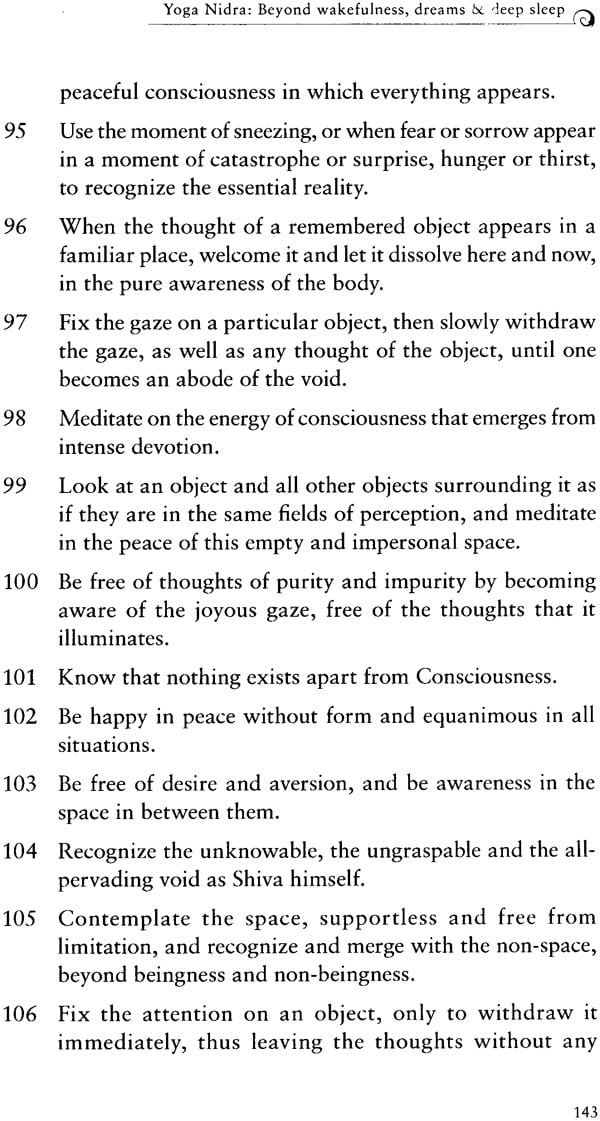
Yoga Nidra (Beyond Wakefulness, Dreams and Deep Sleep)
Book Specification
| Item Code: | NAN984 |
| Author: | Pierre Bonnasse |
| Publisher: | Zen Publications |
| Language: | English |
| Edition: | 2016 |
| ISBN: | 9789385902215 |
| Pages: | 151 |
| Cover: | Paperback |
| Other Details | 9.0 inch X 6.0 inch |
| Weight | 220 gm |
Book Description
Discover Your innermost through deep relaxation
Yoga nidra is an ancestral practice that comes form grand Indian raditions and philosophies stemmed in Hinduism, Buddhism and Tantrism. This unique form of yoga seeks to combine deep relaxation with attentive awareness, in order to consciously explore wakefulness, dreams and deep sleep and awaken to the unborn reality beyond these three states. Moreover, it offers ways of putting the mind and the body to sleep, while keeping the awareness alert.
Through its positive, stabilizing and appeasing effect on the body emotions and thoughts, yoga nidra is also a therapeutic technique that has considerably influenced modern techniques like Sophrology, a Ertern relaxation method, widely practised in France today. It allows one to experience moments of great inner tranquillity, joy and well-being. This practice combines very simple gestures and postures with light and subtle breathing exercises, as well as concentration and meditation, thereby allowing the alert observation of sensation, an abandonment to the phenomena that appears and a return to the present moment, in order to taste the luminous and blissful presence to oneself and to the world, by day or by night.
This book about 'the sleep of the sages' takes us on a journey to the unknown and the mysterious, to the luminous presence to the unconscious mind, full of discoveries encounters and tastes; the art of taking a nap, a creative approach for lazing around and another way of looking at life...
Having embraced the Indian way of life and philosophy, Pierre Bonnasse, also known as Chitragupta, spends his time between France and India, especially in Rishikesh. He has studied under the guidance of different spiritual Masters for more than twenty years and teaches yoga, meditation and Indian philosophy. Inspired byt he teachings of Ramana Maharshi, Shri Nisargadatta Maharaj, Swami Chinmayanda, Swami Rama and Dhri Aurobindo, his approach consists in linking philosophical ideas and practise of India and the West. He is also the author of more than twenty books (essays, travel stories and poetry), several articles and translations in French. Some of his books have translated and published spiritual in Italy, America and India. He has written about his personal spiritual experiences, famous Masters and his meetings with remarkable beings encountered during his travels in sacred places like Varanasi, Chidambaram and Tiruvannamalai, especially in the Arunachala mountain which has deeply influenced his life. He co-founded the Rishi Yoga Shala School, offering yoga training programs in India and in France, with courses conducted in English, French and Hindi.
Yoga Nidra is an ancestral practice that comes from grand Indian traditions and philosophies stemmed in Hinduism, Buddhism and Tantrism. This unique form of yoga seeks to combine deep relaxation with attentive awareness, in order to consciously explore the state of wakefulness, dream and deep. Moreover, it offers ways of putting the mind and the body to sleep, while keeping the awareness alert. This highly comprehensive approach has inspired the discipline of Sophrology and allows to experience moments of great inner tranquillity, joy and well-being; one can directly observe particular physiological, emotional and mental processes within oneself and understand them in a better ways. By knowing "that which is held on to", it is easier to let go of it and recognize the essential space of one's being free from all states and processes. This practice combines very simple gestures and postures with light and subtle breathing exercises, as well as concentration and meditation, thereby allowing the alert observation of sensations, an abandonment to the phenomena that appear and a return o the present moment, in order to taste the luminous and blissful presence to oneself and to the world, by day or by night.
Practicing Yoga Nidra does not require any particular physical condition or quality, like strength, stamina or flexibility. Very simple poses (sitting, standing and lying down) are used; they are adaptable to every individual and bring deep relaxation, as well as high quality attention and tranquillity.
Through its positive, stabilizing and appeasing effect on the body emotions and thoughts, Yoga Nidra is also a therapeutic technique that has considerably influenced modern techniques. Its practice reinforces joy, good spirits and the immunity system, thus preventing diseases, especially psychosomatic ones. It is the ideal practice for getting rid of stress, anxiety and the fear of dearth, which Yoga Noirda considers to be at the source of all other fears.
By connecting Indian and Western philosophical ideas, and by drawing on the teachings of important spiritual masters, we will see how sleep can be an opportunity to practice a form of yoga that is absolutely delicious and that changes not only our nights, but also every minute of our days.
This book about "the sleep of the sages" taken us on a journey to the unknown and the mysterious, to the luminous presence to the unconscious mind, full of discoveries encounters and tastes; the art of taking a nap, a creative approach for lazing around and another way of looking at life...
In India, one believe that tall paths, everywhere in the world lead to the same Mystery that man has never stopped looking for, whether he knows it or not. The term "Hinduism", coined by the British to label something that they did not understand, has no meaning; it tries to put the rites, practices and philosophical schools of thought of this ancient land into one single basket, which cannot contain them all. The term "Sanatana Dharma" is more suited, as it designates not only the myriad of goods, goddesses and practices, but also and above all, the "Eternal Philosophy", in the literal sense of the word, not as a theoretical discourse or an intellectual discipline, but as life-support or a law of life itself, "what really is", be it on an uncreated level as well as on a phenomenal level. This has nothing to do with an opinion. "Dharma", impossible to translate into our modern languages, is the objective law that reigns the whole universe, whether I know it or not. The concepts of social laws, moral and religious rules come much later, and are only a pale expression of it. This "Eternal Philosophy" is celebrated for the first time in the ancient texts said to be "revealed" or "heard" that are the Vedas: "knowledge" or "science" divided into four parts. They were composed by the visionary sages of ancient India. The Rig Veda, "the knowledge of verses", is the most ancient (1500 BC). It contains formulae (mantra) and hymns. The Absolute is called Brahman. He is omnipresent, impersonal and without form. The Sama Veda is "the knowledge of the hymns", of melodies. The Yajur Veda talks about "the knowledge of sacrificial formulae". The Atharva Veda, "the knowledge of Atharvan", is composed of incantations, chants and prayers. These are followed by the interpretations and comments in the Brahmanas, esoteric texts called the Aranyakas and the auxiliary disciplines associated with the study of the Vedas: phonetics, rituals, grammar, etymology, meter and astronomy-astrology. But the essence of this "Revelation" is crystallized in the famous philosophical manuals called the Upanishads, literally meaning "to sit at the Master's feet", a finale to the Vedic canon, thus marking the accomplishment and the end of knowledge (Vedanta). They can be summarized in the four "Great Sayings" (mahavakya), related to each of the four Vedas, to be memorized and meditated on. The first statement defines the "Truth": "Consciousness is Brahman?', The second saying teaches us that the nature of our identity is ONE with Absolute Reality: "Thou art That". The third seems to be the statement of direct experience: "This Self (or Atman) is Brahman". Finally, the fourth, like a song of gratitude, realization and liberation: -r am Brahman". Amongst the Vedic lords, let us mention Indra, the God of War "who is powerful"; Mitra, the "friend" and Varuna, the "sky", the custodians of order. Agni, the "fire", and Rudra, the "roarer", he who makes you "cry", and who shares many features with the famous god of the yogis, Shiva, "The Auspicious One", mentioned in the later scriptures, as well as Vishnu, the "omnipresent", he who "pervades". And there are many others, sun gods, goddesses, demons and other geniuses that mythology enthusiasts are sure to look up in the corresponding texts.
This "eternal philosophy" is also celebrated in the "remembered" texts that constitute the entire foundation of the Indian tradition; the epics are the texts that are the most accessible to all, and are thus far more popular than the "heard" texts known to priests, scholars and a few spiritual seekers. The epics, while responding and referring to the authoritative revealed texts, speak to a large number of people through the story and mythology of its gods and goddesses, with a sense of profound philosophy. They include legendary and famous sagas like the Mahabharata (whose Bhagavad Gita is considered to be a part of the revealed knowledge), and the Ramayana. In these stories, the One, the impersonal Brahman of the "revealed" texts, takes multiple forms, more human and thus more similar to the people, who in turn can easily identify with the "descendants" (avatar) of Vishnu, such as Krishna or Ram, or their companions. These texts also include mythological and religious collections that discuss the creation of the Universe, the secondary creations, the ancestry of gods and sages, the creation of the human race and of the first men, and the history of dynasties in a traditional manner. Most of them were written between the years 400 and 1200 BC. There are also tantric textbooks that exist, the "books of law" that mention moral precepts, codes of conduct, laws, legal treaties, penal codes, fixed by grand legislators such as Manu, who tries to accord the Vedic spirit to the present era. But Dharma is not a dogma and these texts were not necessarily followed, nor even considered popular enough by the British, who tried to impose a framework to a Reality that could not be limited to one particular setting.
For understanding this "eternal philosophy" or "eternal truth" that cannot be seized by the intellect, Indian tradition offers several "points of view" (darshana), accepted by the Vedic authority. The nyaya, literally meaning "original nature", is the school of logic, founded by the ancient logician and philosopher Akshapada Gautama. It studies the means of knowledge, based on logical analysis and reasoning, by developing, for example, linguistic semantics. The vaisheshika, meaning "particular, specific", is a school of the systematic that classifies concepts; this philosophical and discriminative doctrine goes back to the first century, and it is traditionally credited to Kanada and his Vaishesika Sutra, composed of ten books. It allows for perceiving the characteristic differences between things. Its major ideas are of an ontological and systematic nature; the concepts are classified into six categories: substance, quality, activity, generic and discriminative substratum, and inherence. The samkhya, the "measurable", is the school of progressive discrimination of substances, based on discrimination and credited to Kapila, whom some consider to be a manifestation of Vishnu. This point of view enunciates universal structures or the macro cosmos, and postulates a supreme principal, classifying elements into several categories. Yoga, "to harness" (yuj), is the exercise of spiritual communion, the means and the goal, the union with the highest Consciousness. Codified by Patanjali in his Yoga Sutras, the "king of yoga" (Raja Yoga) describes man's inner universe from the theist perspective of the samkhya. This is an integral practice, a means of inner investigation to know the Self, traditionally divided into eight limbs or stages iashtangai', The mimamsa is about hermeneutics, the exegesis of the Vedic ritual, other rituals and ceremonies. The Mimamsa Sutra, exposing this doctrine, came after the fourth century, but is credited to Jaimini, who is also the author of an essay on domestic rituals. Finally, the Vedanta, literally meaning "the end of knowledge", designates the culmination of Indian philosophy in "non-duality" (advaita). This school is credited to Vyasa. It is the philosophy exposed in the Upanishads, made famous and developed by Adi Shankaracharya (788 - 820 AD), "the benevolent Master" who lived in Varanasi, where he taught this direct philosophy. He is credited with numerous writings; he founded four monasteries, at the source of several schools of thought, and had an important influence and authority on this teaching of non-duality, "popularized" by grand sages such as Ramana Maharshi, Nisargadatta Maharaj or Swami Chinmayananda. This path invites one to recognize the Self through three distinct forms of yoga, respectively involving the body, the emotions and the mind: Karma Yoga, the path of action; Bhakti Yoga, the path of devotion; Jnana Yoga, the path of self-enquiry. The essence of these three classical forms of yoga are naturally involved with other forms of practice, and in the end, all the paths come together in the space of direct experience.
The Limbs and Paths of Yoga
In his famous Yoga Sutras, Patanjali enunciates eight "limbs" or "stages" of Raja Yoga that lead to the realization of the highest Consciousness. The first limb (yama) invites us to observe and cultivate five qualities, directly linked with our relation with others: benevolence, or non-violence, truthfulness, non-stealing, celibacy and non-possessiveness. Inextricably linked with the latter, the second limb (niyama) directly refers to our relation with ourselves, and consists in the cultivation of purity, moderation or contentment, the strength acquired by asceticism, the knowledge acquired by the reading of sacred texts, and the "faith" acquired by meditation. Some may see this as a simple code of conduct, but the Tantric schools prefer to set it aside for diverse reasons; that being said, these observances are of invaluable aid in cultivating the tranquility that is necessary for the practice of yoga. They are also, from another point of view, the fruits of serious asceticism. The third limb (asana) concerns postures, the way of "staying" and the mastery of the body in general. The fourth stage (pranayama) encourages the "control of breath" by observing it attentively, as well as the practice of codified breathing exercises. These first four limbs are essentially related to the outer aspect of the discipline; the other four limbs will directly immerse us in the very core of inwardness. The fifth limb calls for the "withdrawal of the senses" (pratyahara), allowing the attention to come back, beyond the sensory levels. The sixth limb (dharana) is "concentration", the ability to maintain one's attention on a single point. The seventh limb (dhyana), naturally following its precedent, is "meditation" and consists in remaining in an impersonal and equanimous observation where the attention is free and non-oriented. In meditation, the dualistic subject-object relationship is transcended, thus opening the door to the eighth limb (samadhi), which is profound contemplation, total "fusion" with the original Vision, and an answer to the definition of yoga initially provided by Patanjali: "yoga is the stopping of the fluctuations of the mind'". It is this suspension of the agitations of the mind - along with the help of these different "limbs" - that will allow for the unveiling of pure consciousness, of being, of peace, silence and joy. Stopping the flow of thoughts allows one to experience the divine non-dualistic reality in which these very thoughts appear and disappear. This "extinction" of thoughts, and consequently of the ego (the sense of "me"), in the vibrating void of awareness can also be that ultimate experience that the Buddhists call nirvana. Even though they are several types of Samadhi, its Reality is a matter of direct experience and cannot be understood through concepts.
The "limbs" of yoga cannot be limited to those mentioned by Patanjali. The Tantric schools - which follow non-orthodox "points of view" and do not necessarily answer to the Vedic and religious authorities - enunciate other components of the path of yoga. In addition to the first two "moral" observations, there are cleansing techniques (for the lungs, nose, intestines, etc.), specific contractions, formulae, gestures, eye exercises, diagrams, energetic massages, rituals, therapeutic practices and other interesting methods that are very precise and that incorporate the others. Yoga Nidra is one of these practices.
| Foreword | 7 | |
| Introduction: Perspectives on Indian Philosophy | 9 | |
| The Limbs and Paths of Yoga | 13 | |
| 1 | The Philosophy of Yoga Nidra | 15 |
| The origins of Yoga Nidra | 15 | |
| States of consciousness | 23 | |
| Who am I? | 27 | |
| The Sheaths of the being | 28 | |
| Awareness, energy, elements and states of matter | 30 | |
| Qualities of sleep | 32 | |
| An approach to Indian psychology | 34 | |
| The manifestation of phenomena | 36 | |
| The energy system in Yoga | 39 | |
| The phenomenal world and constructions of the mind | 44 | |
| The unconscious mind | 45 | |
| Fears, desires and suffering | 49 | |
| Sleep and death | 52 | |
| 2 | The Practice of Yoga Nidra | 57 |
| Yoga Nidra as a practice | 57 | |
| The limbs of yoga according to the Nidra tradition | 61 | |
| Poses | 62 | |
| Breathing | 64 | |
| Gestures and Locks | 65 | |
| Withdrawal of the sense and concentration | 66 | |
| Meditation and deep contemplation | 67 | |
| Preparatory exercises | 68 | |
| Exercises for falling asleep | 70 | |
| Exercises for the night | 77 | |
| Exercises for waking up | 78 | |
| Yoga of dreams - Svapna Yoga | 79 | |
| "Protocol" for Yoga Nidra | 82 | |
| Preparation (prastuti) | 83 | |
| Deep relaxation (shithilikarana) | 83 | |
| The face force of intention (sankalpa) | 85 | |
| Rotation of consciousness (chetana sancharana) | 86 | |
| The countdown | 90 | |
| Working with themes | 90 | |
| Visualizations | 94 | |
| Merging with the heart | 95 | |
| Resolve (sankalpa) and final phase (samapti) | 96 | |
| The art of living in total awareness | 97 | |
| Electricity does not die when bulb is broken | 99 | |
| Fields of application for Yoga Nidra | 100 | |
| The ultimate surrender | 103 | |
| Annexes | ||
| Session 1: | Blue Star (Nilatara Yoga Nidra) | 109 |
| Session 2: | Contemplation of the elements (Mahabhuta Visarga Yoga Nidra) | 117 |
| Session 3: | From the sound AUM to "non-contact" (Pranava Asparsha Yoga Nidra) | 124 |
| Session 4: | The Art of Dying (Marana Yoga-Nidra) | 127 |
| The taste of yogic sleep: An interview with Pierre Bonnasse | 131 | |
| 112 practices to inspire and create your sessions | 134 | |
| Bibliography | 146 | |
| About the Author | 151 |
